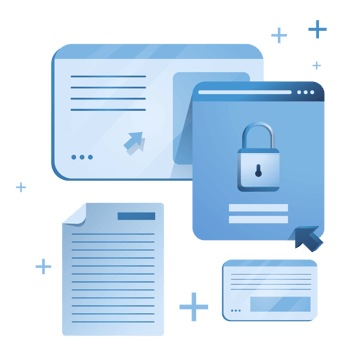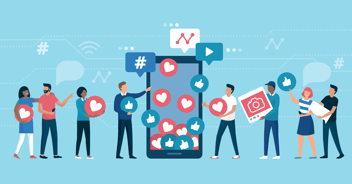Outbound Marketing pentru leaduri și creșterea afacerii tale
Dacă urmăriți tendințele în materie de marketing digital, s-ar putea să credeți că inbound marketingul este la modă, iar outbound marketingul este învechit. Cu toate acestea, alegerea strategiei potrivite pentru compania dvs.necesită să fiți deschis ambelor abordări, deoarece aveți nevoie de ele în eforturile dvs. de generare de lead-uri.
Ce este marketingul outbound?
Outbound marketing este o strategie de marketing tradițională care implică contactarea activă a potențialilor clienți prin diverse canale, cum ar fi publicitatea, e-mailul, telemarketingul, evenimentele și relațiile publice.
-
Marketingul outbound urmărește să atragă atenția persoanelor interesate de un produs sau serviciu și să le încurajeze să întreprindă o acțiune specifică, cum ar fi efectuarea unei achiziții, participarea la o întâlnire de vânzări sau înscrierea la un buletin informativ.
-
Marketingul outbound poate fi o modalitate eficientă de a genera clienți potențiali și de a stimula vânzările, dar poate fi, de asemenea, costisitor și consumator de timp și poate fi doar uneori bine primit de public.
Printre exemplele de marketing outbound se numără reclamele televizate, reclamele radio, anunțurile tipărite, campaniile de corespondență directă și apelurile directe.
Un tânăr marketer pe care autorul îl cunoaște a definit marketingul outbound în felul următor:
"Outbound marketing este un miliard de moduri diferite de a codifica o reclamă pop-up. Este o întrerupere pentru că implică contactarea activă a oamenilor și perturbarea activităților lor normale. Este ca și cum ar cere atenție totală. Este ca și cum, super-in-your-face".
Desigur, este, de asemenea, posibil să se elaboreze mesaje outbound care "atrag atenția" și "atrag atenția" în loc să fie "super-in-your-face". Cele mai reușite anunțuri de outbound marketing îi lasă pe telespectatori cu sentimentul că întreruperea merită atenția lor. Dar cum puteți codifica un mesaj de outbound marketing pe care consumatorii să îl prefere față de ceea ce au văzut sau ascultat deja? Cum ar trebui Outbound să sprijine obiectivele mele SMART? Outbound este o abordare relevantă, de sprijin pentru Inbound Lead Generation.
Trei necesități pentru o campanie de marketing outbound de succes
Clienții de toate tipurile, dar în special clienții B2B, controlează din ce în ce mai mult modul în care iau decizii de cumpărare. Ei se așteaptă să interacționeze cu vânzătorii printr-o combinație coordonată de canale de vânzări și interacțiuni cu compania dumneavoastră, atât de la om la om, cât și digitale. Ei se așteaptă la soluții de produse care să corespundă exact nevoilor lor personale și de afaceri. Acest tip de personalizare necesită multă muncă pentru a fi realizat. Dar realizarea acestuia începe cu un plan de structurare a marketinguluioutbound.
Andris Zoltners, profesor pensionat de la Școala de Management Kellogg a Universității Northwestern și autor al cărții The Power of Sales Analytics, îi sfătuiește pe marketerii digitali să se gândească la marketingul outbound și inbound ca la activități complementare ale centrelor de cerere. Un centru de cerere colectează activitățile care generează lead-uri (marketing outbound, cum ar fi e-mailuri, webinare, evenimente și plasare în media plătită) și le combină cu conținutul personalizat din generarea de lead-uri inbound și interacțiunea umană cu oamenii de vânzări.
Uneori, un centru de cerere furnizează conținut digital. Uneori, un centru de cerere se concentrează pe interacțiunea umană. Cu toate acestea, centrul de cerere își prioritizează și își rafinează constant interacțiunile cu lead-urile, prospectele și clienții pentru a se conecta cu clienții la momentul potrivit în ciclul de cumpărare.
Scriitoarea de afaceri Sally Lorimer ajută de peste 30 de ani companiile să dezvolte texte pentru eforturile de marketing outbound și inbound. Ea identifică trei condiții prealabile pentru succesul marketingului outbound.
Eforturile de marketing și vânzări trebuie să fie interactive.
În mod tradițional, departamentul de marketing generează clienți potențiali cu ajutorul marketingului outbound, iar apoi departamentul de vânzări preia conducerea cu ajutorul marketingului inbound. Însă clienții perturbă adesea această secvență. De exemplu, este posibil ca un client să vadă o reclamă pop-up sau să participe la un webinar al companiei dvs. care îl determină să își reconsidere decizia de cumpărare.
Acest lucru înseamnă că metrica de succes a departamentului de marketing poate fi diferită de numărul de clienți potențiali pe care îl generează. Marketingul și vânzările din fiecare centru de cerere trebuie să măsoare succesul prin volumul în dolari al vânzărilor pe care le generează.
Campaniile de marketing pot viza mai mult decât doar produse și segmente de piață.
Deoarece clienții nu rămân într-un singur loc în pâlnia de marketing, este util doar uneori să concepeți o campanie de marketing outbound în jurul atingerii unui anumit tip de client. Și pierdeți vânzări dacă vă limitați eforturile de marketing și vânzări la un singur produs. În schimb, marketingul și vânzările, adică outbound marketing și inbound marketing, și prospectarea trebuie să se concentreze pe cucerirea factorilor de decizie, nu doar pe publicitatea și vânzarea produselor.
Marketingul digital capătă un rol mai important.
Pe măsură ce clienții preiau din ce în ce mai mult controlul asupra interacțiunilor lor cu furnizorii, este esențial ca atât marketingul, cât și vânzările să dispună de conținutul digital de care clienții au nevoie atunci când au nevoie de el. Conținutul digital pregătit pentru a sprijini clienții și vânzătorii autodirecționați este esențial pentru succes.
Un nou rol pentru inteligența artificială
Organizarea eforturilor de marketing outbound și inbound în jurul centrelor de cerere este deosebit de importantă pentru companiile B2B care vând în principal întreprinderilor mici și mijlocii. Acestea trebuie să ajungă la mai mulți factori de decizie pe diferite canale simultan. Inteligența artificială poate ajuta specialiștii în marketing și vânzătorii cu sugestii privind următoarea cea mai bună acțiune, cu privire la ceea ce trebuie să facă în fiecare punct al conversației cu clientul.
Inteligența artificială poate urmări care dintre factorii de decizie intră în contact cu conținutul sau cu un vânzător. Ea poate urmări intensitatea angajamentului față de conținut și față de conversațiile de vânzare. Algoritmul poate informa apoi marketingul și vânzările cu privire la modalitățile de personalizare a parcursului fiecărui client. În același timp, inteligența artificială acordă ponderi dinamice interacțiunilor pentru a determina momentul în care fiecare client este pregătit să ajungă la decizia de cumpărare.
Când trebuie să mă concentrez pe outbound marketing?
Chiar și într-o epocă în care clienții sunt din ce în ce mai independenți, există încă momente în care trebuie să vă concentrați pe marketingul outbound. Iată câteva exemple.
-
Ați realizat o inovație într-un produs sau serviciu esențial. Tocmai ați obținut aprobarea FDA pentru un nou medicament minune. Sau aveți o modalitate de a vă ajuta clienții să facă față unui șoc iminent al prețurilor. Sau oricând aveți un nou produs, serviciu sau preț despre care clienții ar dori să știe dacă ar învăța să întrebe.
-
Aveți date convingătoare despre cine vă cumpără produsul și când. Trimiterea de e-mailuri către persoanele care iau decizii de cumpărare intră în această categorie. La fel se întâmplă și cu publicitatea în publicații de nișă, la târguri de specialitate și pe YouTube și Facebook cu un public clar definit.
-
Trebuie să mișcați acul cu cifrele dvs. de vânzări. Există un element de "a arunca ceva acolo și a vedea dacă se lipește" în fiecare campanie de marketing outbound. Asumarea unor riscuri măsurate și calculate pentru a dezvolta clienți potențiali și a testa noi piețe poate fi exact ceea ce aveți nevoie pentru a revitaliza vânzările.
Ați putea fi sigur că vă coordonați eforturile de marketing outbound și inbound într-un singur centru de cerere? Clienții moderni solicită o experiență fără stres cu furnizorii lor. Nevoile lor nuanțate de cumpărare se ciocnesc în mod inevitabil cu modelele de segmentare a clienților și cu obiectivele de vânzări ale produselor. Solicitările care le ocupă timpul îi vor face să își piardă interesul față de compania dvs. dacă sunt nevoiți să caute informații și răspunsuri în diferite părți ale organizației dvs. de marketing și vânzări. Pentru a avea succes, marketingul outbound trebuie să fie perfect integrat cu marketingul inbound și cu vânzările.
Centrele de cerere nu încep ca niște mașini bine unse. Chiar și cei mai experimentați specialiști în marketing digital beneficiază de consilieri cu experiență vastă în diverse produse pentru diverse afaceri și medii. Aspiration Marketing vă poate sprijini programele de marketing inbound și outbound și vă poate ajuta să fiți proactivi față de potențialii clienți și să creșteți odată cu compania dumneavoastră.
Acest conținut este disponibil și în:
- Germană: Wann ist Outbound Marketing das beste Tool um Leads zu generieren?
- Engleză: When to Use Outbound Marketing to Generate Leads + Grow Your Business
- Spaniolă: Cuándo usar outbound marketing para generar leads y crecer tu negocio
- Franceză: Quand utiliser l'Outbound Marketing pour générer des leads ?
- Italiană: Outbound Marketing per lead: quando usarlo?
- Chineză: 何时使用呼出营销来创造潜在客户+发展业务


-1.jpg?width=800&height=533&name=melanie-deziel-U33fHryBYBU-unsplash%20(1)-1.jpg)




Lasă un comentariu cu părerea ta.